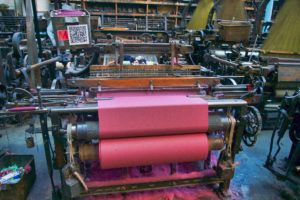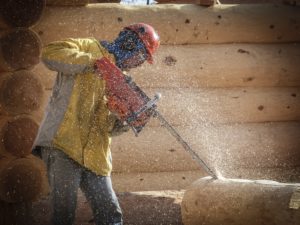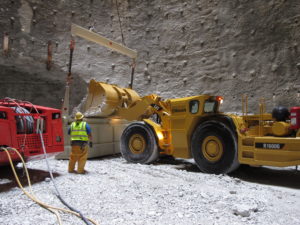Work-related COPD: What are the risks?
COPD in the Workplace
 Chronic obstructive pulmonary disease (COPD) is a respiratory condition that causes breathing problems, including coughing, wheezing, shortness of breath, and mucus production and is characterized by chronic bronchitis and emphysema [1,2,3]. It is one of the most common chronic respiratory diseases in Canada, and continues to be a major cause of death and disability [1,2]. Smoking is the most common cause of COPD, but an estimated 25-45% of COPD patients have never smoked [4].
Chronic obstructive pulmonary disease (COPD) is a respiratory condition that causes breathing problems, including coughing, wheezing, shortness of breath, and mucus production and is characterized by chronic bronchitis and emphysema [1,2,3]. It is one of the most common chronic respiratory diseases in Canada, and continues to be a major cause of death and disability [1,2]. Smoking is the most common cause of COPD, but an estimated 25-45% of COPD patients have never smoked [4].
Furthermore, the American Thoracic Society and European Respiratory Society estimate that 14% of all COPD is caused by workplace exposures [5]. Workplace exposures may be responsible for as much as 32% of COPD cases among non-smokers [3]. Studies have shown increased risk of COPD associated with workplace exposure to biological and mineral dusts (e.g. silica, asbestos, wood, cotton, coal, grain), gases and fumes (e.g. welding fumes, diesel engine exhaust, asphalt fumes), and pesticides [8-12]. Work-related exposures, in combination with smoking, can also further increase risk of COPD [6-7]. It is likely that occupational exposure to vapours, gases, dusts, and fumes (VGDF) is additive to that of smoking which can lead to increased lung function impairment and development of COPD [13].
Occupational Disease Risks
The following results show the percent increase in risk among groups of workers by industry or occupation compared to all other workers followed in the ODSS. Industry and occupation results are shown in the same tables for each group of workers. Results shown are for diagnoses of COPD prior to age 65, which are more likely to be related to exposures at work than COPD diagnoses among older individuals. It is important to note that COPD diagnoses may not be based on lung function criteria, which can lead to misclassification of COPD with other respiratory conditions such as asthma.
No data were available for cigarette smoking in the ODSS, so some observed occupational risks may be due to smoking patterns. On the other hand, studies of respiratory disease among workers in dusty, often physically demanding workplaces may under-estimate occupational risks because people with chronic lung disease may avoid these occupations and workers experiencing respiratory symptoms are more likely to transfer to less exposed occupations or leave the workforce [14]. This is called the “healthy worker effect.” The ODSS attempts to address these issues by comparing each occupation and industry to all others workers in the system, rather than to the general population [14]. The over 2 million workers in the ODSS are people who received workers’ compensation in the past and the great majority were employed in hazardous jobs where smoking rates and physical demands may be similar.
Farming
 Residence and employment in agricultural and rural environments are often associated with a lower risk of disease. However, farming exposures have been linked to some adverse health outcomes including respiratory diseases such as COPD. Although farmers commonly have lower smoking rates than other workers and the general population, increased risk of respiratory diseases had been previously observed which may be related to occupational exposures [15-17].
Residence and employment in agricultural and rural environments are often associated with a lower risk of disease. However, farming exposures have been linked to some adverse health outcomes including respiratory diseases such as COPD. Although farmers commonly have lower smoking rates than other workers and the general population, increased risk of respiratory diseases had been previously observed which may be related to occupational exposures [15-17].
An increased risk for COPD was observed for several farming industries and occupations in the ODSS. Workers in farming may be exposed to a variety of dusts, pesticides, and diesel engine exhaust, which may increase their risk of COPD. Livestock farm workers are exposed to dusts including animal dander, hair, animal feed, and other microbiological components [18-20] including ammonia, methane and hydrogen sulphide from animal manure [21-22]. Workers cultivating crops have previously been reported to have lower COPD risk than those who also had livestock exposure [23-24]. This was consistent with findings in the ODSS cohort, where the highest risk was observed for crop and livestock combination farms workers. Compared to other workers, increased risk of COPD was also observed among crop farmers and workers in the feed industry, where exposure to grain dusts and molds can be common [23]. Farm workers that use diesel-powered equipment (i.e. tractors) may be exposed to diesel engine exhaust, which has also been associated with increased risk of COPD [6].
| Industry or Occupation | Increased risk |
| Nursery and related occupations | 25%* |
| Farm work occupations | 24%* |
| Other crop and livestock combination farms industry | 51%* |
| Field crop and field crop combination farms industry | 42%* |
| Feed industry | 39%* |
| *Statistically significant (α=0.05) | |
Flour and grain milling and baking
In addition to the increased risk observed among grain producers and handlers in the agricultural sector, previous studies have also indicated increased risks among workers that process grains into flours, as well as among bakers working with those flours [21,25-26]. Workers in flour and grain milling and baking jobs have shown increased risks of COPD in the ODSS. Flour dusts from various cereals can contain contaminants including fungi, endotoxins, chemical additives, and insects and mites [27]. Several studies have identified an increased prevalence of respiratory symptoms and lung function decline among mill and bakery workers [21,28-30], with the highest risk among workers with sensitization to allergens, particularly fungal amylase present in flour improvers [21,31].
| Industry or Occupation | Increased risk |
| Flour and grain milling | 44% |
| Baking, confectionery making and related | 26%* |
| *Statistically significant (α=0.05) | |
Textile
 Workers in textile processing can be exposed to a variety of organic and synthetic dusts, with reported pulmonary function declines differing across materials. The strongest evidence exists for exposure to cotton dust, contaminated with endotoxins, which has been linked to acute airway responses (e.g. coughing, narrowing of airway) with short-term exposure and loss of pulmonary functions and inflammation with longer exposure [14, 32-33]. The highest risk of COPD observed among textile workers in the ODSS was for those employed in the cotton yarn and cloth mills industry. Large variations in exposure to inhalable dust and airborne endotoxin have been observed across different textile processing sectors [34].
Workers in textile processing can be exposed to a variety of organic and synthetic dusts, with reported pulmonary function declines differing across materials. The strongest evidence exists for exposure to cotton dust, contaminated with endotoxins, which has been linked to acute airway responses (e.g. coughing, narrowing of airway) with short-term exposure and loss of pulmonary functions and inflammation with longer exposure [14, 32-33]. The highest risk of COPD observed among textile workers in the ODSS was for those employed in the cotton yarn and cloth mills industry. Large variations in exposure to inhalable dust and airborne endotoxin have been observed across different textile processing sectors [34].
| Industry or Occupation | Increased risk |
| Textile processing occupations | 27%* |
| Cotton yarn and cloth mills industry | 75%* |
| Automobile fabric accessories industry | 66%* |
| Man-made fibre, yarn and cloth mills industry | 51%* |
| *Statistically significant (α=0.05) | |
Wood processing, pulp and paper, and forestry
 In the ODSS worker cohort, increased risk was observed for several wood related occupations, and in the wooden box factory industry, but no excess risk was observed for the broader logging or forestry industries. Previous studies have observed increased risks of respiratory symptoms and conditions among workers exposed to wood dust [35-36], but evidence regarding COPD and specific causal agents remains mixed [37-39]. Fresh wood dust may contain fungi, endotoxin, and gram-negative bacteria [40-41]. In addition to dusts from wood, workers in wood products fabrication may be exposed to a variety of respiratory irritants including waxes, resins, glues, and formaldehyde in the production and use of MDF (medium-density fiberboard) [42]. Bleaching workers in wood pulp mills are also exposed to ozone, a known respiratory irritant, and chlorine dioxide/sulphur dioxide gassings which have also been shown to have obstructive effects on airflow and pulmonary function [43]. Timber cutting and related forestry work can result in pesticide exposure which has been shown to accelerate lung function decline and increase risk of COPD [12].
In the ODSS worker cohort, increased risk was observed for several wood related occupations, and in the wooden box factory industry, but no excess risk was observed for the broader logging or forestry industries. Previous studies have observed increased risks of respiratory symptoms and conditions among workers exposed to wood dust [35-36], but evidence regarding COPD and specific causal agents remains mixed [37-39]. Fresh wood dust may contain fungi, endotoxin, and gram-negative bacteria [40-41]. In addition to dusts from wood, workers in wood products fabrication may be exposed to a variety of respiratory irritants including waxes, resins, glues, and formaldehyde in the production and use of MDF (medium-density fiberboard) [42]. Bleaching workers in wood pulp mills are also exposed to ozone, a known respiratory irritant, and chlorine dioxide/sulphur dioxide gassings which have also been shown to have obstructive effects on airflow and pulmonary function [43]. Timber cutting and related forestry work can result in pesticide exposure which has been shown to accelerate lung function decline and increase risk of COPD [12].
| Industry or Occupation | Increased risk |
| Labouring and other elemental work in pulp and papermaking occupations | 80%* |
| Labouring and other elemental work in fabricating, assembling and repairing wood products occupations | 48%* |
| Wood sawing and related occupations (except sawmills) | 46%* |
| Timber cutting and related occupations | 45%* |
| Wooden box factories industry | 94%* |
| *Statistically significant (α=0.05) | |
Construction
Workers in construction trades occupations showed increased risks of COPD. These workers are exposed to a number of possible risk factors for COPD, including many different dusts (e.g. silica, cement, concrete, wood, metal), fibres (e.g. asbestos), and irritant fumes (e.g. asphalt, engine exhausts, metal welding) [3,37,44]. This makes it challenging to identify particular causative agents, but increased risk of COPD has been observed for construction workers in previous studies [3,8,45-46].
| Industry or Occupation | Increased risk |
| Insulating | 78%* |
| Labouring and other elemental work in excavating, grading and paving | 75%* |
| Painters, paperhangers and related | 58%* |
| Roofing, waterproofing and related | 54%* |
| Labouring and other elemental work in construction trades | 45%* |
| Concrete finishing and related | 38%* |
| *Statistically significant (α=0.05) | |
Mining
 Workers in mining have historically been exposed to high levels of dusts and fine particles, including silica, as well as diesel engine exhaust from heavy machinery. These exposures have been linked to increased risk of COPD among miners [37,44,47-48]. The greatest COPD risk observed among ODSS mining industry workers was for workers in quarries and sand pits, which may be due to their exposure to silica [49-51]. There may be less monitoring of workplace dust exposure in quarry and sand pit workers, who are likely to be working in open spaces, compared to other mining workers.
Workers in mining have historically been exposed to high levels of dusts and fine particles, including silica, as well as diesel engine exhaust from heavy machinery. These exposures have been linked to increased risk of COPD among miners [37,44,47-48]. The greatest COPD risk observed among ODSS mining industry workers was for workers in quarries and sand pits, which may be due to their exposure to silica [49-51]. There may be less monitoring of workplace dust exposure in quarry and sand pit workers, who are likely to be working in open spaces, compared to other mining workers.
| Industry or Occupation | Increased risk |
| Labouring and other elemental occupations in mining and quarrying | 36%* |
| Cutting, handling and loading occupations in mining and quarrying | 23%* |
| Stone quarries industry | 73%* |
| Sand pits or quarries industry | 61%* |
| Services incidental to mining industry | 53%* |
| *Statistically significant (α=0.05) | |
Metal processing and welding
A consistent excess risk of COPD was observed for workers in metal processing and welding related industries and occupations. These workers may be exposed to heavy metals (e.g. cadmium, arsenic, chromium), welding fumes, crystalline silica and dusts, solvents and other agents that may increase the risk for COPD in these workers [22]. Exposure to heavy metals and welding fumes can cause oxidative damage, among other mechanisms, which can increase susceptibility to lung infection and worsen lung function [51-53].
| Industry or Occupation | Increased risk |
| Metal rolling occupations | 46%* |
| Labouring and other elemental work in metal processing occupations | 46%* |
| Moulding, coremaking and metal casting occupations | 33%* |
| Metal smelting, converting and refining furnacemen occupations | 29%* |
| Welding and flame cutting occupations | 18%* |
| Iron foundries industry | 68%* |
| Copper and copper alloy rolling, casting and extruding industry | 65%* |
| *Statistically significant (α=0.05) | |
Exposure Controls and Risk Recognition
 Understanding your risk and recognizing the symptoms of COPD allows for early detection and treatment. Symptoms of COPD include shortness of breath (especially during physical activity), tiredness, persistent cough, cough with phlegm, wheezing, and multiple diagnoses of cold, flu, or pneumonia that are slow to recover. If you have any of these symptoms, you should visit your health care provider and tell them about the work you do [54]. Diagnosis of COPD should include lung function tests and early detection of COPD can help to reduce problems with lung function and breathing that often lead to damage of the lungs [54,55].
Understanding your risk and recognizing the symptoms of COPD allows for early detection and treatment. Symptoms of COPD include shortness of breath (especially during physical activity), tiredness, persistent cough, cough with phlegm, wheezing, and multiple diagnoses of cold, flu, or pneumonia that are slow to recover. If you have any of these symptoms, you should visit your health care provider and tell them about the work you do [54]. Diagnosis of COPD should include lung function tests and early detection of COPD can help to reduce problems with lung function and breathing that often lead to damage of the lungs [54,55].
Public health, employer and occupational health, as well as regulatory efforts to reduce the population burden of COPD need to address workplace exposures in addition to the cumulative exposure with smoking. Medical professionals should be aware of risks among high-risk occupational groups in order to identify early stage disease. Workplace health promotion and workers should recognize the benefits of smoking cessation programs in preventing and managing work related respiratory disease.
Workers diagnosed with or who suspect they have COPD can also submit a claim through the Workplace Safety and Insurance Board (WSIB). Recent changes have been made where benefits will no longer be offset for most workers who have a history of smoking and submit a claim for COPD [56].
There is also the National Lung Health Framework action plan that was developed to improve lung health in Canada and help to coordinate prevention and management approaches of respiratory conditions [57]. These efforts can enhance prevention and management of respiratory diseases like COPD and improve health outcomes and economic benefits.
References
- Asthma and Chronic Obstructive Pulmonary Disease (COPD) in Canada, 2018 – Canada.ca [Internet]. Ottawa, Ontario, 2018 [cited 2020 Sep 9]
- Najafzadeh M, Marra CA, Lynd LD, Sadatsafavi M, FitzGerald JM, McManus B, et al. Future Impact of Various Interventions on the Burden of COPD in Canada: A Dynamic Population Model. PLoS One [Internet], 2012, 7(10).
- Dement, J., Welch, L., Ringen, K., Quinn, P., Chen, A., & Haas, S. A case-control study of airways obstruction among construction workers. Am J Ind Med, 2015, 58(10): 1083–1097. https://doi.org/10.1002/ajim.22495.
- Salvi, S. S., & Barnes, P. J. Chronic obstructive pulmonary disease in non-smokers. Lancet. 2009, 374(9691): 733–743.
- Blanc PD, Annesi-Maesano I, Balmes JR, Cummings KJ, Fishwick D, Miedinger D, et al. The Occupational Burden of Nonmalignant Respiratory Diseases. An Official American Thoracic Society and European Respiratory Society Statement. Am J Respir Crit Care Med [Internet], 2019, 199(11):1312–34.
- Blanc PD, Iribarren C, Trupin L, et al. Occupational exposures and the risk of COPD: dusty trades revisited. Thorax, 2009, 64:6-12.
- Blanc, P. D., Eisner, M. D., Earnest, G., Trupin, L., Balmes, J. R., Yelin, E. H., Gregorich, S. E., & Katz, P. P. Further exploration of the links between occupational exposure and chronic obstructive pulmonary disease. J Occ Env Med, 2009, 51(7), 804–810.
- Bergdahl IA, Torén K, Eriksson K, Hedlund U, Nilsson T, Flodin R, et al. Increased mortality in COPD among construction workers exposed to inorganic dust. Eur Respir J, 2004, 23(3):402–6.
- Omland Ø, Würtz ET, Aasen TB, Blanc P, Brisman J, Miller MR, et al. Occupational chronic obstructive pulmonary disease: A systematic literature review. Scand J Work Environ Heal, 2014, 40(1):19–35.
- Hart JE, Laden F, Schenker MB, Garshick E. Chronic obstructive pulmonary disease mortality in diesel-exposed railroad workers. Environ Health Perspect, 2006, 114(7):1013–7.
- Public Health Agency of Canada. Chronic Obstructive Pulmonary Disease (COPD). [cited 2020 Sep 10].
- Lytras T, Kogevinas M, Kromhout H, Carsin AE, Antó JM, Bentouhami H, et al. Occupational exposures and 20-year incidence of COPD: The European Community Respiratory Health Survey. Thorax, 2018.
- WSIB. Causes, diagnosis, and progression of COPD following workplace exposure to vapours, gases, dusts and fumes. 2021.
- Lai, P.S., & Christiani, D. C. (2013). Long-term respiratory health effects in textile workers. Curr Op Pul Med, 19(2), 152-157.
- Monsó E, Riu E, Radon K, Magarolas R, Danuser B, Iversen M, Morera J, Nowak D. Chronic obstructive pulmonary disease in never‐smoking animal farmers working inside confinement buildings. Am J Ind Med, 2004 (4):357-62.
- Stoleski, S., Minov, J., Karadzinska-Bislimovska, J., Mijakoski, D., Atanasovska, A., & Bislimovska, D. Asthma and Chronic Obstructive Pulmonary Disease Associated With Occupational Exposure in Dairy Farmers – Importance of Job Exposure Matrices. Open Access Maced J Med Sci., 2019, 7(14), 2350–2359.
- Chronic bronchitis, COPD, and lung function in farmers: the role of biological agents. Eduard W, Pearce N. Douwes J Chest. 2009, 136(3):716-725.
- Garcia J, Bennett DH, Tancredi D, Schenker MB, Mitchell D, Reynolds SJ, Mitloehner FM. Occupational exposure to particulate matter and endotoxin for California dairy workers. Int J Hyg Environ Health. 2013, 216(1):56-62.
- Smit LA, Wouters IM, Hobo MM, et al. Agricultural seed dust as a potential cause of organic dust toxic syndrome, Occup Environ Med, 2006, 63 (59-67).
- Simpson J, Niven R, Pickering C, et al. Comparative personal exposures to organic dusts and endotoxin, Ann Occup Hyg, 1999, 43 (pg. 107-15).
- Rushton L. Occupational causes of chronic obstructive pulmonary disease. Rev Env Health, 2007, 22(3), 195–212.
- Silver SR, Alarcon WA & Li J. Incident chronic obstructive pulmonary disease associated with occupation, industry, and workplace exposures in the Health and Retirement Study. Am J Ind Med, 2021, 64: 26-38.
- Eduard, W., Pearce, N., & Douwes, J. Chronic bronchitis, COPD, and lung function in farmers: the role of biological agents. Chest, 2009, 136(3), 716–725.
- Guillien A, Puyraveau M, Soumagne T, Guillot S, Rannou F, Marquette D, Berger P, Jouneau S, Monnet E, Mauny F, Laplante JJ, Dalphin JC, Degano B. Prevalence and risk factors for COPD in farmers: a cross-sectional controlled study. Eur Respir J. 2016, 47(1):95-103.
- Hamdy A. Mohammadien, Mona T. Hussein, Raafat T. El-Sokkary, Effects of exposure to flour dust on respiratory symptoms and pulmonary function of mill workers, Egyptian Journal of Chest Diseases and Tuberculosis, 2013, 62(4): 745-753.
- Patouchas D, Efremidis G, Karkoulias K, Zoumbos N, Goumas P & Spiropoulos K. Lung function measurements in traditional bakers. Acta Biomed, 2008, 79(3):197-203.
- Stobnicka A & Gorny RL. Exposure to flour dust in the occupational environment. Int J Occup Saf Ergon. 2015, 21(3): 241-249.
- Pahwa, P., Senthilselvan, A., McDuffie, H. H., & Dosman, J. A. Longitudinal estimates of pulmonary function decline in grain workers. Am J Respir Crit Care Med, 1994, 150(3), 656–662.
- Baur, X., Degens, P. O., & Sander, I. Baker’s asthma: still among the most frequent occupational respiratory disorders. J Allergy Clin Immunol, 1998, 102(6 Pt 1), 984–997.
- Massin N, Bohadana AB, Wild P, Kolopp-Sarda MN & Toamain JP. Airway responsiveness to methacholine, respiratory symptoms, and dust exposure levels in grain and flour mill workers in eastern France. Am J Ind Med, 1995 Jun;27(6):859-69.
- Smith, T. A., Lumley, K. P., & Hui, E. H. Allergy to flour and fungal amylase in bakery workers. Occ Med, 1997, 47(1), 21–24.
- Christiani DC, Wang XR. Respiratory effects of long-term exposure to cotton dust. Curr Opin Pulm Med. 2003;9:151–55.
- Mayan O, Torres Da Costa J, Neves P, et al. Respiratory effects among cotton workers in relation to dust and endotoxin exposure, Ann Occup Hyg, 2002, 46 (pg. 277-80)
- Priyamvada Paudyal, Sean Semple, Robert Niven, Gael Tavernier, Jonathan G. Ayres, Exposure to Dust and Endotoxin in Textile Processing Workers, The Ann Occ hyg, 2011, 55(4): (403–409).
- Jacobsen, G., Schaumburg, I., Sigsgaard, T., Schlünssen, V. Non-malignant respiratory diseases and occupational exposure to wood dust. Part II. Dry wood industry. Ann Agric Environ Med, 2010, 17(1), 29-44.
- K. Hosseini D, Malekshahi Nejad V, Sun H, K. Hosseini H, Adeli SH, Wang T. Prevalence of respiratory symptoms and spirometric changes among non-smoker male wood workers. PLoS ONE, 2020, 15(3): e0224860.
- Mastrangelo G, Tartari M, Fedeli U, Fadda E & Saia B. Ascertaining the risk of chronic obstructive pulmonary disease in relation to occupation using a case-control design. Occ Med, 2003, 53:165–172
- G. Jacobsen, V. Schlünssen, I. Schaumburg, E. Taudorf, T. Sigsgaard. Longitudinal lung function decline and wood dust exposure in the furniture industry. Eur Respir J, 2008, 31(2), 334-342.
- Vested A, Basinas I, Burdorf A, et al. A nationwide follow-up study of occupational organic dust exposure and risk of chronic obstructive pulmonary disease (COPD). Occ Env Med, 2019, 76:105-113.
- Verma DK, Demers C, Shaw D, Verma P, Kurtz L, Finkelstein M, des Tombe K, Welton T. Occupational health and safety issues in Ontario sawmills and veneer/plywood plants: a pilot study. J Environ Public Health, 2010:526487.
- Dennekamp M, Demers P, Bartlett K, Davies H, Teschke K. Endotoxin exposure among softwood lumber mill workers in the Canadian province of British Columbia. Ann Agric Environ Med. 1999;6(2):141-6.
- Thetkathuek, A., Yingratanasuk, T., & Ekburanawat, W. (2016). Respiratory Symptoms due to Occupational Exposure to Formaldehyde and MDF Dust in a MDF Furniture Factory in Eastern Thailand. Adv Prev Med, 2016, 3705824.
- Mehta AJ, Henneberger PK, Toren K & Olin AC. Airflow limitation and changes in pulmonary function among bleachery workers. Eur Respir, 2005, 26(1):133-9.
- Fell, AKM, Aasen TOB & Kongerud J. Work-related COPD. Tidsskr Nor Laegeforen. 2014, , 134(22):2158-63.
- Borup, H., Kirkeskov, L., Hanskov, D., & Brauer, C. Systematic review: chronic obstructive pulmonary disease and construction workers. Occ Med, 2017, 67(3), 199–204.
- Torén, K., & Järvholm, B. Effect of occupational exposure to vapors, gases, dusts, and fumes on COPD mortality risk among Swedish construction workers: a longitudinal cohort study. Chest, 2014, 145(5), 992–997.
- Mabila, S., Almberg, K., Friedman, L., & Cohen, R. High exposure mining occupations are associated with obstructive lung disease, National Health Interview Survey (NHIS), 2006‐2015. Am J Ind Med, 2018, 61(9), 715–724.
- Ferguson, J., Costello, S., Elser, H., Neophytou, A., Picciotto, S., Silverman, D., & Eisen, E. Chronic obstructive pulmonary disease mortality: The Diesel Exhaust in Miners Study (DEMS). Env Res, 2020, 180, 108876–.
- Hnizdo, E., & Vallyathan, V. Chronic obstructive pulmonary disease due to occupational exposure to silica dust: a review of epidemiological and pathological evidence. Occ Env Med, 2003, 60(4), 237–243.
- Möhner, M., & Nowak, D. Estimation of an Exposure Threshold Value for Compensation of Silica-Induced COPD Based on Longitudinal Changes in Pulmonary Function. Int J Environ Re Public Health, 2020, 17(23), 9040–.
- Koh, DH, Kim JI, Kim KH, Yoo Sw & the Korea Welders Cohort Group. Welding fume exposure and chronic obstructive pulmonary disease in welders. Occ Med, 2015, 65(1): 72-77.
- Hassan F, Xu X, & Nuovo G et al. Accumulation of metals in GOLD4 COPD lungs is associated with decreased CFTR levels. Res Res, 2014, 15: 69.
- Rokadia HK & Agarwal S. Serum heavy metals and obstructive lung disease results from the national health and nutrition examination survey. Chest, 2013, 143(2): P388-397.
- Breathe The Lung Association. (2019). Chronic Obstructive Pulmonary Disease (COPD).
- Health and Safety Executive. G401 Health monitoring for chronic obstructive pulmonary disease.
- WSIB. (2021). Chronic obstructive pulmonary disease – discontinuation of smoking offset for non-economic loss benefits.
- Government of Canada. (2019). Chronic Respiratory Diseases.
Surveillance Bulletins
The Occupational Disease Surveillance System (ODSS) Surveillance Bulletins provide summaries of occupational exposures and disease risks across different industries and occupational groups. The aim of these bulletins is to report on high risk occupations and industries and specific exposures detected through occupational disease surveillance. At this time the ODSS includes workers from 1983-2014 and follows their health outcomes until 2016. This bulletin reflects only the diseases currently tracked within the ODSS. The system is updated and expanded on an ongoing basis.
More information about the ODSS including data sources, methods and detailed results can be found at ODSP-OCRC.ca and OccDiseaseStats.ca.
